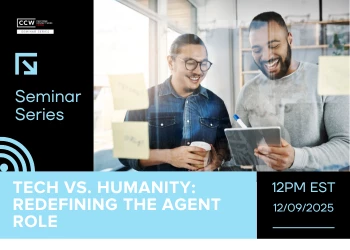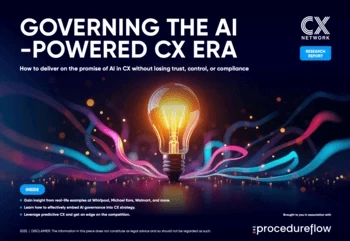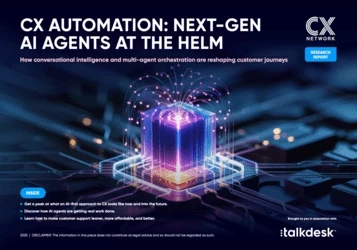Is AI is changing what CX means?
It’s changed everything else, now there’s a growing question mark over whether the next generation of business tools is changing the meaning of CX
Add bookmark
Artificial intelligence (AI) is changing everything about business, from how we collect and utilize data, to our workflows, and the ease at which we can scale operations. In the last two years, generative and agentic AI have taken this further, introducing a whole new set of capabilities around automation, support, hyper-personalization, and more.
As our contributor Raluca Berchiu, founder and CEO of CXM Strategic, recently wrote, agentic AI in particular “introduces a new organizational architecture where intelligence and CX converge, integrating data, decision-making and adaptive execution across every business function.”
But AI in all its forms is changing customer experience (CX), employee experience (EX), and organizational culture and – with input from CX Network Advisory Board members Nao Anthony and Jaslyin Qiyu – this article covers how this is driving the need to reassess what CX means in the AI era.

Don't miss any news, updates or insider tips from CX Network by getting them delivered to your inbox. Sign up to our newsletter and join our community of experts.
The fundamental reassessment of CX
There are many new things your next CX strategy will need to incorporate in order to keep ahead during fast-moving times, and our recent article lists 12 of them. However, according to Jaslyin Qiyu, CMO and head of CX for Singapore and Australia at Cigna Healthcare, the first step to planning is to conduct “a fundamental reassessment of what customer experience means in an AI-enabled environment”.
Qiyu says: “Your CX strategy doesn't need another initiative – it needs a fundamental reassessment of what customer experience means in an AI-enabled environment.”
This means siloed channels are “no longer defensible”, as strategy must “center on unified customer context that travels seamlessly across every touchpoint”.
“This requires breaking down organizational walls, not just implementing integration middleware,” she says.
It also requires a re-think on how and why customer data are collected. Qiyu says customers increasingly understand they're trading data for convenience and that “smart strategies make this exchange explicit and valuable”. Therefore, practitioners should clarify what information they’re capturing, how it improves the customer’s experience, and give meaningful control. “Trust becomes the currency that enables personalization,” she explains.
To do this, practitioners must shift investment from reactive support to predictive intervention. “The math is compelling: preventing issues costs a fraction of resolving them. Build capabilities that identify and address friction before customers experience it. This isn't just better service – it's fundamentally more efficient,” she says.
The next consideration is human: automation is not about creating an alternative to or competition for human service, and the constant evolution of technology requires ongoing skill development.
“Develop frameworks where AI handles routine complexity while routing nuanced situations to empowered specialists. The handoff quality matters more than the automation percentage,” she says.
One case in point is Klarna. CEO Sebastian Siemiatkowski announced in September 2024 that he had stopped hiring humans and instead planned to automate more processes, including some in the customer service suite. The cost management exercise was intended to create a lean, mean, lending machine ahead of its IPO, but a year later Siemiatkowski U-turned after being forced to put engineers on the service desk to answer customer queries.
“Your strategy must include ongoing skill development for teams, regular process optimization, and organizational adaptability,” Qiyu continues.
She adds: “One-time transformations are dead; continuous evolution is the new steady state. Stop using AI as an excuse for letting people go, ensure your people are constantly reskilled and upskilled.”
6 ways to reimagine your CX strategy
Nao Anthony, senior manager of operational excellence at Commonwealth Bank (CBA), agrees with the need for practitioners to reimagine their CX strategies and advises they do so through “six essential lenses”.
“CX strategy, just five years ago, was built around a familiar set of priorities – speed to market, digital interfaces, customer value, and consistency across the journey,” Anthony says. “Those priorities haven’t changed, but their meaning has evolved. In the dawn of AI, speed now extends beyond delivery; it’s about intelligent anticipation, responsiveness, and creating value before the customer even asks.”
Furthermore, he says the evolution from generative AI to agentic AI marks “a defining shift in how organizations and customers interact”.
Whereas generative AI executes prompt-based tasks, agentic AI goes a step further, acting autonomously by drawing from historical patterns, contextual understanding, and predictive insight to decide what to do, when, and why. “This shift will not only redefine customer experience, it will also fundamentally reshape the relationship between consumers, organizations, and value itself,” he says.
The six essential lenses through which Anthony says organizations must reimagine their CX strategies, are:
1. Meet basic needs – flawlessly and consistently
Anthony says there is zero margin for error in meeting fundamental customer expectations. “In the AI-enabled era, automation and intelligent systems have laid the groundwork for seamless, trustworthy engagement. Customers equate consistency with reliability — and reliability with trust,” he explains.
2. Manage expectations – and over-deliver
CX leaders must intentionally shape and exceed customer expectations. “Deep understanding of customer personas and journey touchpoints allows teams to experiment with meaningful uplifts that leave a lasting impression. Every interaction should feel designed, not incidental,” Anthony says.
3. Ground ambition in capability
Organizations often overestimate their operational maturity, which means that while digital transformation “may paint a promising picture”, Anthony says early success “can mask underlying functional weaknesses”. He adds: “A sleek interface or predictive capability means little if the backend can’t sustain it. CX leaders must understand their true organizational capacity to ensure investments target areas that most influence experience quality”.
4. Take a value-chain view
AI has exposed both the power and the gaps across the customer value chain, Anthony says and this means excellence in one phase of the journey “means little if friction exists elsewhere”. “CX transformation must therefore align strategy, technology, and the value chain itself to eliminate sub-optimization and deliver end-to-end value,” he advises.
5. Embrace iterative transformation
Although it feels very different, the era of “big-bang” transformation is behind us. “Neither customers nor organizations find value in long, waterfall-style deployments that risk irrelevance upon delivery,” Anthony says. “The new currency is continuous value creation delivering tangible improvements early, often, and adaptively. ‘Fail fast’ has matured into ‘deliver value, no matter how small’,” he says.
6. Ask less, predict more
Customers expect simplicity and speed, which means re-creating paper-based processes in digital form is no longer transformation, it’s a translation. “CX leaders must critically examine every customer data request, ensuring it serves a clear purpose. Intelligent automation at the back end and frictionless digital engagement at the front end define the next frontier of logical, human-centered digitalization,” Anthony says.
“In summary, the principles of great CX haven’t changed, but the playbook has,” Anthony says. “In an AI-driven world, experience is no longer about what customers do with us; it’s about how intelligently we anticipate and respond to what they need.”
Click here for more insights on what your next CX strategy should include
Quick links
- Building the future-ready contact center
- How generative AI search is changing the customer journey
- Navigating the complexities of multilingual CX in a globalized economy




























